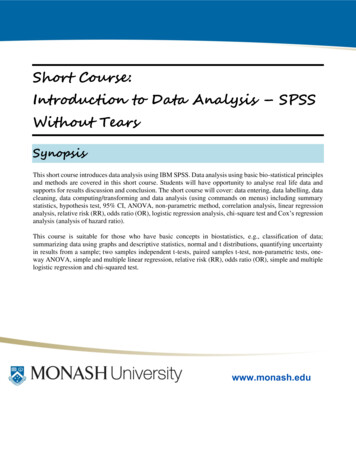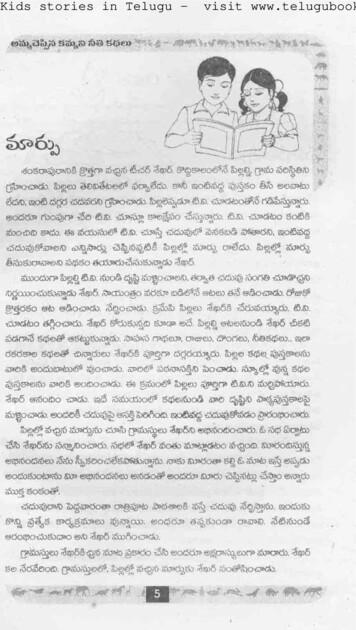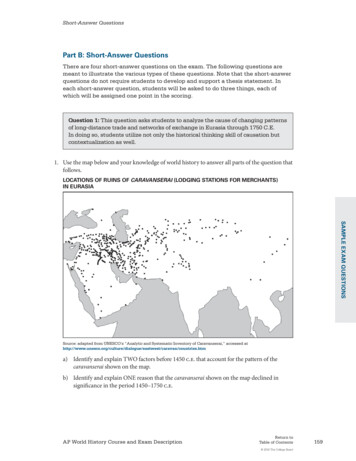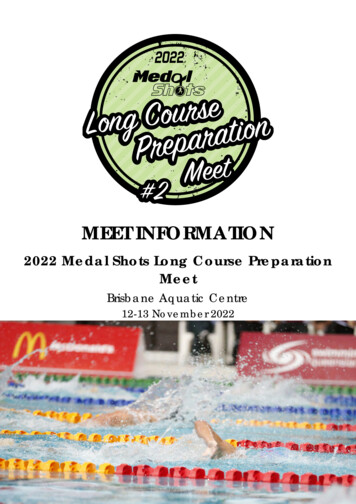
Transcription
Short Course:Introduction to Data Analysis – SPSSWithout TearsSynopsisThis short course introduces data analysis using IBM SPSS. Data analysis using basic bio-statistical principlesand methods are covered in this short course. Students will have opportunity to analyse real life data andsupports for results discussion and conclusion. The short course will cover: data entering, data labelling, datacleaning, data computing/transforming and data analysis (using commands on menus) including summarystatistics, hypothesis test, 95% CI, ANOVA, non-parametric method, correlation analysis, linear regressionanalysis, relative risk (RR), odds ratio (OR), logistic regression analysis, chi-square test and Cox’s regressionanalysis (analysis of hazard ratio).This course is suitable for those who have basic concepts in biostatistics, e.g., classification of data;summarizing data using graphs and descriptive statistics, normal and t distributions, quantifying uncertaintyin results from a sample; two samples independent t-tests, paired samples t-test, non-parametric tests, oneway ANOVA, simple and multiple linear regression, relative risk (RR), odds ratio (OR), simple and multiplelogistic regression and chi-squared test.www.monash.edu
Learning OutcomesUpon successful completion of this short course, attendees should be able to:1. Presenting data using relevant tables, graphical displays, and summary statistics.2. Analysing data to compare significance of difference between two or more groups: parametric and nonparametric methods.3. Evaluating association between disease (outcome) and one or more exposures.5. Quantifying short and long-term risk of having the disease among exposed groups.6. Data creation, cleaning and managements.Details of Learning Outcomes Lab1: Be familiar with basic SPSS functions and its tools. These functions and tools will enablestudents to proficiently open and create SPSS data files.Lab 2: Presenting data using SPSS generated graphs and summary statistics: descriptive statistics.Lab 3: Conducting independent and paired samples t-tests to compare two groups.Lab 4: Conducting a one-way ANOVA to compare more than two groups where the test variable iscollected on a continuous scale and the data in each group follows the normal distribution: One-wayANOVA.Lab 5: Analysing data when normality assumption for data does not hold, i.e., the data does not followthe normal distribution. The statistical methods to analyse such data are collectively known as NonParametric methods or distribution free method: non-parametric tests.Lab 6: Evaluating the association between an outcome and one or multiple exposures where outcome iscontinuous however, exposure could be numerical or categorical or a combination of both: correlationand linear regression analysis.Lab 7: Quantifying the risk of the disease (outcome) in the exposed group compared to the unexposedgroup: relative risk and odds ratio. Assessing the association between an outcome and an exposurewhere both of them are categorical, and both have two or more categories or a combination of both: chisquare analysis.Lab 8: Evaluating the association between an outcome and one or more exposures where outcome iscategorical BINARY but exposure could be numerical or categorical or a combination of both: logisticregression analysis.Lab 9: Evaluating the association between an outcome and one or more exposures where outcome iscategorical BINARY and time dependent but exposure could be numerical or categorical or acombination of both: survival analysis.Lab 10: Managing our data (entering, labelling, creating, cleaning, merging, etc.)Copyright Monash University 2014. All rights reserved. Except as provided in the Copyright Act 1968, this work may not be reproduced in any formwithout the written permission of the host Faculty and School/Department.2
Table: Summary of SPSS Lab activities anddata requiredDaysLab No. &descriptionActivityData required1: Familiarising with SPSS2: Describing data3: Two samples t-testsActivities 1.1-1.3Activities 2.1-2.9Activities 3.1-3.2Activities 3.34: One-way ANOVAActivities 4.1-4.2Activity 4.3Activities 5.1-5.3Disease Y dataDisease Y dataDisease Y dataBlood pressure data(BP data)FEV1 dataRepeated IP dataPA lipid dataDay 15: Non-parametric testsDay 26: Correlation & regression7: RR, OR & chi-squared test8: Logistic regression9: Survival analysis10: Data creation, cleaning& managementActivities 6.1 – 6.5Activities 7.1 – 7.3Activities 8.1 – 8.3Activities 9.1 – 9.3Disease Y dataDisease Y dataDisease Y dataStomach Cancer dataDisease Y dataNote: Please see the DATA folder for data & AUDIO-Video folder for audio-video for activities in the Lab. Noaudio-video available for Labs 7, 9 and 10.Copyright Monash University 2014. All rights reserved. Except as provided in the Copyright Act 1968, this work may not be reproduced in any formwithout the written permission of the host Faculty and School/Department.4
Important Review of Biostatistics Summary statistics:o Mean and standard deviation (SD), median and percentiles or interquartile range(IQR) Mean and median measure the central value of a measurements, e.g, fastingHbA1c for people with diabetic. SD and IQR measure the dispersion of measurements from their central value(mean and IQR respectively)o Standard error (SE): Measures the dispersion or uncertainty in the calculated summarystatistics, i.e., it tells us how far the study result from the parameter (e.g., efficacy of adrug) of interest.o Correlation: Measures the association between disease and exposure. It falls between-1 and 1. A negative value of correlation shows that the association is reverse, e.g.,weekly exercise hours and body mass index (BMI). A positive value of correlation shows that the association is the samedirectional, e.g., oestriol level of pregnant women near full term andsubsequent birth weight. A higher value of correlation shows a stronger association.o Regression coefficients or beta coefficients: Measures the effect of an exposure on thedisease or outcome. Beta has no limit, can be positive or negative. A positive valueshows a positive association and a negative value shows a negative association. Higherthe value, stronger the evidence.o Relative risk (RR) & Odds ratio (OR): Quantify the risk of the disease in the exposedgroup compared to unexposed group, e.g., risk of having lung-cancer among thesmokers (exposed group) compared to non-smokers (unexposed group).o Hazard ratio (HR): Quantifies the hazard or risk of long-term survival from a disease inthe exposed group compared to unexposed group, e.g., survival of cancer patientsreceiving cameo therapy compared to patients receiving cameo therapy radiotherapy.Hypothesis:o Null hypothesis: A hypothesis/statement of no difference or association betweendisease and exposure.o Alternative hypothesis: A hypothesis/statement of a difference or association betweendisease and exposure.Decision on the NULL hypothesis:o Calculate the p-value If the p-value 0.05, stay with the null hypothesis, i.e., the study result is notsignificant. If the p-value 0.05, reject the null hypothesis, i.e., the study result issignificant.Copyright Monash University 2014. All rights reserved. Except as provided in the Copyright Act 1968, this work may not be reproduced in any formwithout the written permission of the host Faculty and School/Department.5
o Calculate the 95% CI: Single Group: Comparing the study results with a standard clinical practice: If the CI includes the standard practice, the difference is not significant. If the CI excludes the standard practice, the difference is significant. Two Groups: Comparing study results between two groups, e.g., betweenplacebo and drug treated patients to evaluate the efficacy of the drug. If the CI includes ZERO, the difference is not significant. If the CI excludes ZERO, the difference is significant. Regression coefficient and Correlation: If the CI includes ZERO, the association is not significant. If the CI excludes ZERO, the association is significant. RR, OR and HR: If the CI includes 1, the risk of the disease is not significant.If the CI excludes 1, the risk of the disease is significantCopyright Monash University 2014. All rights reserved. Except as provided in the Copyright Act 1968, this work may not be reproduced in any formwithout the written permission of the host Faculty and School/Department.6
7: RR, OR & chi 8: Logistic regression Day 2 6: Correlation & regression Activities 6.1 - 6.5 Disease Y data -squared test Activities 7.1 -7.3 Disease Y data Activities 8.1 -8.3 Disease Y data 9: Survival analysis Activities 9.1 - 9.3 Stomach Cancer data 10: Data creation, cleaning & management Disease Y data











